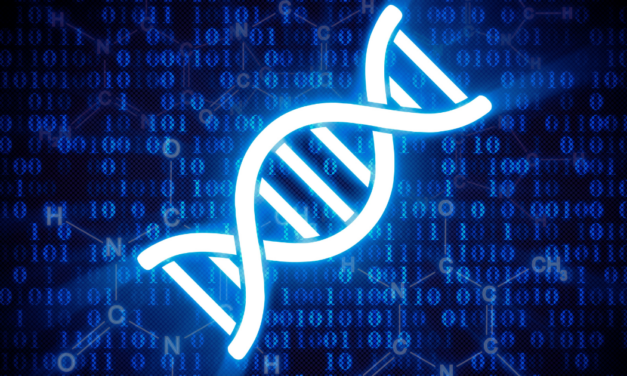This article first appeared in CHRISTIAN RESEARCH JOURNAL, volume 35, number 01 (2012). The full text of this article in PDF format can be obtained by clicking here. For further information or to subscribe to the CHRISTIAN RESEARCH JOURNAL go to: http://www.equip.org/christian-research-journal/
When James Watson and Francis Crick elucidated the structure of DNA in 1953, they solved one mystery but created another.
For almost a hundred years after the publication of Charles Darwin’s The Origin of Species, biology rested secure in the knowledge that it had explained one of mankind’s most enduring mysteries. From ancient times, observers had noticed organized structures in living organisms—the elegant form of the coiled nautilus, the interdependent parts of the eye, the interlocking bones, muscles and feathers of a bird wing—gave the appearance of having been designed for a purpose.
But with the advent of Darwinism, and later neo-Darwinism, modern science claimed to explain the appearance of design in life as the product of a purely undirected process. In his Origin of Species, Darwin argued that the striking appearance of design in living organisms—in particular, the way they are so well adapted to their environments—could be explained by natural selection working on random variations, a purely undirected process that nevertheless mimicked the powers of a designing intelligence. Thus, as evolutionary biologist Francisco Ayala notes, Darwin accounted for “design without a designer.”1 Or, as Francis Crick has explained, biologists must “constantly keep in mind that what they see was not designed, but rather evolved.”2
But due in large measure to Watson and Crick’s own discovery of the information-bearing properties of DNA, scientists have become increasingly and, in some quarters, acutely aware that there is at least one appearance of design in biology that has not been explained by natural selection or any other purely naturalistic mechanism.
When Watson and Crick discovered the structure of DNA in 1953, they also discovered that DNA stores information in the form of a four-character alphabetic code. Strings of precisely sequenced chemicals called nucleotide bases store and transmit the assembly instructions—the information—for building the crucial protein molecules and protein machines the cell needs to survive.
Crick later developed this idea with his famous “sequence hypothesis,” according to which the chemical parts of DNA (the nucleotide bases) function like letters in a written language or symbols in a computer code. Just as letters in an English sentence or digital characters in a computer program may convey information depending on their arrangement, so too do certain sequences of chemical bases along the spine of the DNA molecule convey precise instructions for building proteins.
Indeed, like the precisely arranged zeros and ones in a computer program, the chemical bases in DNA convey instructions in virtue of their “specificity” of arrangement. Thus, software developer Bill Gates observes that “DNA is like a computer program”3 and biotechnology specialist Leroy Hood describes the information stored in DNA as “digital code.”4
But how did this functionally specified information in DNA arise?
In my book, Signature in the Cell, I call this “the DNA enigma.” Moreover, this enigma is closely associated with an even more fundamental problem that Darwin himself did not address. That problem is the origin of the first life. We now know that building even a simple living cell requires a vast amount of genetic information, or digital code. As origin-of-life researcher Bernd-Olaf Küppers has explained, “The problem of the origin of life is clearly basically equivalent to the problem of the origin of biological information.”5
To date, no theory of undirected chemical evolution has explained the origin of the digital information needed to build the first living cell. Why? There is simply too much information in the cell to be explained by chance alone. And the information in DNA has also been shown to defy explanation by reference to chemical laws. Saying otherwise would be like saying that a newspaper headline might arise as the result of the chemical attraction between ink and paper.
More recently, some have claimed that another scenario —the RNA world hypothesis, combining chance and law-like prebiotic natural selection—can solve the origin-of-life problem. But the RNA world hypothesis presupposes, but does not explain, the origin of information in the original functional RNA molecules.
If attempts to solve the information problem only relocate it, and if neither chance nor physical-chemical necessity, nor the two acting in combination, explains the ultimate origin of specified biological information, what does? Do we know of any entity that has the power to create large amounts of specified information? We do.
Experience affirms that functionally specified information routinely arises from the activity of intelligent agents. A computer user who traces the information on a screen back to its source invariably comes to a mind, that of a software engineer or programmer. Similarly, the information in a book or newspaper column ultimately derives from a writer—from a mental, rather than a strictly material, cause.
But could this intuitive connection between information and the prior activity of a designing intelligence justify a rigorous scientific argument for intelligent design? While doing doctoral work at the University of Cambridge in the late 1980s, I became convinced that a rigorous scientific case for intelligent design could be made.
Philosophers of science have argued that historical scientists make “inferences to the best explanation.”6 That is, when trying to explain the origin of an event or structure from the past, scientists often compare various hypotheses to see which would, if true, best explain it. They then provisionally affirm the hypothesis that best explains the evidence as the one that is most likely to be true. But that raises an important question: exactly what makes an explanation best?
Following Darwin historical scientists have developed criteria for deciding which explanation, among a group of competitors, provides the best explanation for some event in the remote past. The most important of these criteria is “causal adequacy.” Causes that are known to produce the effect in question are judged to be better candidate explanations than those that are not. For instance, a volcanic eruption provides a better explanation for an ash layer in the earth than an earthquake because eruptions have been observed to produce ash layers, whereas earthquakes have not.
What did all this have to do with the DNA enigma? Uniform and repeated experience affirms that intelligent agents produce (or cause) information-rich systems, whether software programs, ancient inscriptions, or Shakespearean sonnets. Minds are clearly capable of generating functionally specified information.
Further, experience shows that large amounts of such information (especially codes and languages) invariably originate from an intelligent source—from a mind or a personal agent. In other words, intelligent activity is the only known cause of the origin of functionally specified information, at least starting from purely physical and chemical, as opposed to biological, precursors.7
Indeed, our uniform experience affirms that specified information—whether inscribed in hieroglyphics, written in a book, encoded in a radio signal, or produced in an RNA-world “ribozyme-engineering” experiment—always arises from an intelligent source, from a mind and not a strictly material process. So the discovery of the functionally specified, digital information in the DNA molecule provides strong grounds for inferring that intelligence played a role in the origin of the information in DNA and the first life. Indeed, whenever we find specified information and we know the causal story of how that information arose, we always find that it arose from an intelligent source. It follows that the best, most likely explanation for the origin of the information in DNA is that it too had an intelligent source.
Intelligent design best explains the DNA enigma.
Stephen C. Meyer received his Ph.D. in the philosophy of science from the University of Cambridge. A former geo- physicist and college professor, he now directs Discovery Institute’s Center for Science and Culture. He has authored, edited, or coauthored several books including, most recently, Signature in the Cell: DNA and the Evidence for Intelligent Design (HarperOne, 2009). Signature in the Cell was named a Book of the Year by the prestigious (London) Times Literary Supplement and was ranked one of the Top 10 Best-Selling Books in Science at Amazon.com for 2009.
NOTES
- Francisco J. Ayala, “Darwin’s Greatest Discovery: Design without Designer,” Proceedings of the National Academy of Sciences 104 (2007): 8567–73.
- Francis Crick, Life Itself (New York: Simon and Schuster, 1981).
- Bill Gates, The Road Ahead (New York: Viking, 1995).
- Leroy Hood and David Galas, “The Digital Code of DNA,” Nature 421 (2003): 444–48.
- Bernd-Olaf Küppers, Information and the Origin of Life (Cambridge: MIT Press, 1990).
- Peter Lipton, Inference to the Best Explanation (London and New York: Routledge, 1991).
- Some neo-Darwinians claim that mutation and natural selection can generate new information from pre-existing organisms. But even if these processes can generate enough new information to produce a fundamentally new form of life (which I doubt), that does nothing to explain the ultimate origin of information from nonliving chemicals necessary to produce the first life.










